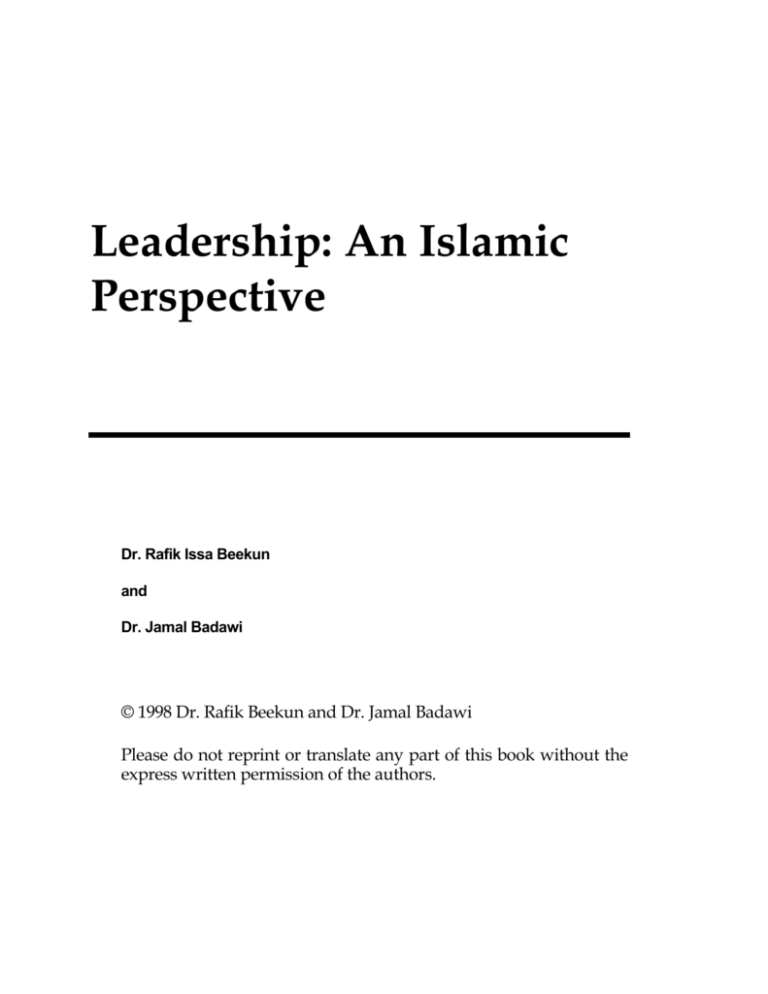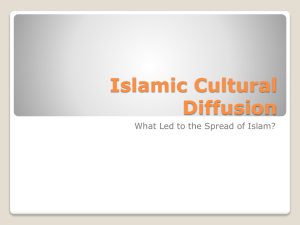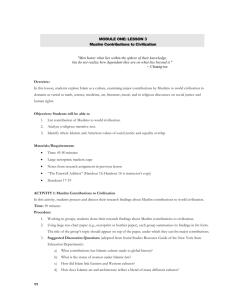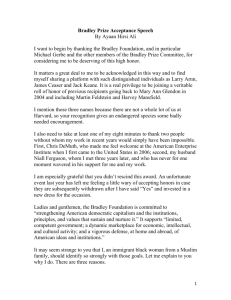Leadership: An Islamic Perspective
advertisement

Leadership: An Islamic
Perspective
Dr. Rafik Issa Beekun
and
Dr. Jamal Badawi
© 1998 Dr. Rafik Beekun and Dr. Jamal Badawi
Please do not reprint or translate any part of this book without the
express written permission of the authors.
1
Leadership: An Islamic Perspective
This book is dedicated to our parents and to a
leader who has inspired many: Khurram Murad.
á
G ·M •I âM ÁI ÃM ƒG šI~ óƒGÀÃM ŠG yM }G yG £Gœ®I ›M ÆG …I wG yH¬ÁM žG æJ ƒR¿¡I }G âM ÁH ƒ«ƒÀG ¾M ƒG·‰G yG
£GÀšG ZD ÂHœ£G˜yG {I ^ƒGƒ˜R¯šZ YG óƒG¥ƒM žI~yG {I ^ƒGƒ¾ƒR³šZ vG £G–~I yG \
I ˆG®ÃM ªG šM Z
ãG žI¬¤I ƒ« “G
And We made them leaders guiding (men) by Our Command and We sent
them inspiration to do good deeds, to establish regular prayers and to
practice regular charity; and they constantly served Us (and Us only).
(Qur’an1, Anbiyaa, 21: 73).
1 The Qur’an is the last of the Divine Book revealed by God (Allah) to His Last Messenger and Prophet
Muhammad (peace be upon him).
2
Table of Contents
Contents
PREFACE
INTRODUCTION
OBJECTIVES OF THIS BOOK:
DEFINING LEADERSHIP
DISTINGUISHING BETWEEN LEADERSHIP, POWER AND AUTHORITY
Position Power
1. Legitimate power
2. Reward power
3. Coercive power
4. Information power
Personal power
1. Expert power
2. Referent or charismatic power
3. Prestige or reputational power
LEADERSHIP ROLES FROM AN ISLAMIC PERSPECTIVE
Servant-leader
Guardian-leader
SOLUTION TO THE 9-DOT PUZZLE
THE MORAL BASES OF ISLAMIC LEADERSHIP
MORAL BASES OF ISLAMIC LEADERSHIP
Iman
Islam
Taqwa
Ihsan
IN FOCUS 2: Cassam Uteem: The People’s President
THE LOCUS OF LEADERSHIP
LEADER CHARACTERISTICS
LEADERSHIP STYLES
FOLLOWER CHARACTERISTICS
SITUATION CHARACTERISTICS
Scoring Matrix
MOBILIZING, DEVELOPING AND ORGANIZING FOLLOWERS
MOBILIZING FOLLOWERS
DEVELOPING FOLLOWERS
ORGANIZING YOUR FOLLOWERS
Sample Job Description for A Volunteer
THE LEADER AS COACH AND MENTOR
WHAT IS COACHING?
THE ROLE OF COACHING
FIVE CRITICAL SKILLS
STAGES OF COACHING
COACHING AS TARBIYYAH AND SELF-DEVELOPMENT
LEADERSHIP AND DELEGATION
Leadership: An Islamic Perspective
BARRIERS TO DELEGATION
Why leaders are reluctant to delegate
Why followers avoid being delegated to
DELEGATION GUIDELINES
How Effective Are You At Delegating?
USING MULTIPLE FRAMES IN LEADERSHIP
BASSAAM ABU DAWUD
Scenario 1:
Alternate scenario 1:
Scenario 2:
Alternate Scenario 2:
Scenario 3:
Alternate Scenario 3:
Scenario 4:
Alternate Scenario 4:
THE FOUR FRAMES
A MODEL OF LEADERSHIP EFFECTIVENESS
STEP 1. CHALLENGING THE PROCESS
STEP 2. INSPIRING A SHARED VISION
STEP 3. ENABLING OTHERS TO ACT
STEP 4. MODELING THE WAY
STEP 5. ENCOURAGING THE HEART
IN FOCUS 4: Khurram Murad-A visionary leader among Da’is
CONCLUSION
SUMMARY
GLOSSARY OF TERMS
BIBLIOGRAPHY
INDEX
3
4
Preface
Preface
In the Name of God2, The Beneficent, The Merciful
Leadership in Islam is a trust (amanah). It represents a psychological contract between a leader and his followers that he will try his best to guide them,
to protect them and to treat them fairly and with justice. Hence, the focus of
leadership in Islam is on doing good.
According to Islam, every person is the “shepherd” of a flock, and occupies
a position of leadership.3 Leadership: An Islamic Perspective is about how Muslims4
enact their leadership role. This book is directed both at Non-Muslims seeking
to understand the leadership paradigm of 1 billion Muslims globally and at
Muslims wishing to understand leadership better.
Why should you be interested in leadership from an Islamic perspective?
Here are some new global facts that relate specifically to the renaissance that
Muslims are currently experiencing:
Muslims are waking up. Look around you. Muslims are coming back together. They are re-uniting. They are standing up for their rights—political
and otherwise. And they are succeeding. Recently, global corporations such as
Nike and American Airlines have backed down in the face of the justified indignation of Muslims in America, and have removed offensive labels or rehired
Muslims. Law enforcement agencies, public institutions as well corporations in
North America are now engaged in diversity training; in addition to other issues
related to minorities, such programs attempt to educate employees about interaction with Muslims. These changes have happened because of the work of
one Muslim organization, Council on American-Islamic Relations (CAIR).
With the help of the Muslim community in North America, CAIR has succeeded in turning back the tide of anti-Islamic coverage in the popular media.
In Britain, the Muslim Council of Britain (MCB) has just recently been set up to
coordinate the voices of all Muslims and Muslim organizations in Great Britain.
Muslims are becoming Ummah5 aware. The rise of regional, and even global,
Muslim-led or Muslim-owned Multinational Corporations (MNCs) such as Hi2 God or Allah. Allah is the essential personal name of God. In this book, we will use both terms interchangeably.
3 Reported by Abd Allah Ibn Umar, Sahih Bukhari, hadith 3.733. The term Hadith refers to the sayings
and actions of Prophet Muhammad (saw).
4 The term Muslim is used throughout the book in its generic meaning to include both males and females
who submit their will to Allah, namely God. All Islamic and/or Arabic terms are explained in the glossary on
page Error! Bookmark not defined..
5 Ummah is an Islamic concept, referring to a community of believers, regardless of racial, ethnic, geographic or other boundaries.
Leadership: An Islamic Perspective
5
com (Malaysia), Savola (Saudi Arabia) or Infocom (USA) indicates that they can
succeed at the global community or Ummah level. The Information Revolution
has also helped Muslims become aware of their common destiny. When they
wake up and see the faces of their raped sisters in Bosnia or the repression of a
whole Muslim people in China, there is immediate empathy and anguish. In
spite of the lukewarm efforts of their own governments, Muslims from many
countries joined up the Bosnians in their efforts to defend themselves against
“ethnic cleansing”.
Education and knowledge management are key. Muslims are beginning to invest
heavily in education and knowledge management, and the results are tangible.
The Pentium chip that powers millions of computers around the world had
several Muslims on the development team. Professor Abdul Wahab El Messiri
is one of the leading authorities in paradigm shifts. Safi Quraishi was one of
the founders of AST, a globally known personal computer manufacter. The
1998 Noble Prize Winner for Medicine was Dr. Ferid Murad. Muslims are realizing that the true source of wealth is not exhaustible oil resources, but intellectual pre-eminence. This realization is leading Muslim countries around the
world to invest in themselves and in the education of future generations on a
massive scale. Malaysia, for example, is investing $40 billion dollars in developing a Multimedia Service Corridor to compete with America’s Silicon Valley.
The leadership paradigm is changing, and ethics is making a comeback. The best sellers in the area of leadership now emphasize sincerity and integrity. The Machiavellian and other self-serving models of leadership which have long dominated contemporary thinking in this area are being dethroned. The House and
Senate Committees on Ethics in the United States have been scrutinizing many
lawmakers’ business transactions and fundraising activities. The superiority of a
leadership model centered on ethical principles is finally emerging—a position
that Islam has embraced since its beginning.
Democracy is on the rise, providing more people with the ability to investigate and practice
Islam. Whenever Muslims or Non-Muslims are allowed more democracy, they
are consistently choosing Islam. Decades of experimentation with alternate
systems of government have been fruitless, and core Islamic values are reasserting themselves. Islam is the fastest growing religion in the United States,
and is now the second largest religion in France.
We assume complete responsibility for all views expressed in the book. We
apologize for any mistake that may have gone unnoticed. We would appreciate
it if the copyrights to this book are not violated by either unauthorized reprinting or translation. Please contact us first for written permission.
Finally, we would like to acknowledge the superb contributions of Dr. Ahmad Sakr, Dr. Hisham Abdallah, Dr. Iqbal Unus, and Nadiah Beekun for their
comments on the manuscript. During one 5-hour international call, Khalid Ali,
6
Preface
former president of the Federation of Student Islamic Societies (FOSIS) in the
UK, provided thorough and expensive feedback to us. These reviewers provided us with detailed, constructive feedback that proved to be invaluable. We
have also learned much from the comments of the participants in our leadership workshops. Finally, we must acknowledge the posthumous contribution
of Khurram Murad throughout this book.
Dr. Rafik I. Beekun
University of Nevada
October 30, 1998
Dr. Jamal Badawi
St. Mary’s University
7
Leadership: An Islamic Perspective
Introduction
Leadership: An Islamic Perspective
âM ÁH ¥G ²
G ÃI·›R âHÁGÀMÃG… £GÀM¿G±G– ãH ©M œG ßG ƒNI …Ge GÍG¿MŠGe GwÂH¿I±MºGž âM •H }G
Í
L ƒ« ‰G eG cG ×
L ·M …G GqMÂG• âM ÁH ´
G ·M …G £GÀ·M •G eG yG £GÃMƒœS¬šZ {I ^ƒGéG šM Z çI•
£R¿ƒIN› K®MÃG‹ G߃N…eG Í
H ¿G ŠM eG yG £Už®I ªM •H £J´·M …G âHÁ´
H ·M …G -G ªI ¥R ÃG šNI
wG ÂH·¿G ¨M žG
Is it they who would portion out the Mercy of your Lord? It is We Who
portion out between them their livelihood in the life of this world: and We
raise some of them above others in ranks so that some may command work
from others. But the Mercy of your Lord is better than the (wealth) which
they amass (Qur’an, Zukhruuf, 43: 32).
Abd Allah Ibn Umar (God be pleased with them) reported that the
Messenger of God (saw)6 said: “Behold! Each of you is a guardian, and
each of you will be asked about his subjects. […]” 7
Objectives of this Book:
After reading this book and doing the leadership exercises included therein,
you should, in sha’ Allah8, be able to:
• Understand the nature and process of leadership from an Islamic perspective.
• Describe the characteristics of effective leaders in general, and of Islamic
leaders in particular.
• Analyze your leadership and followership styles.
• Learn how you can mobilize, organize and develop your followers Islamically.
• Learn how you, as a leader, can build commitment by acting as a coach and
mentor.
• Learn how to delegate effectively.
6 saw: May the peace and mercy of God be upon him. This is a common phrases used by Muslims whenever the name of a prophet is mentioned.
7 Sahih Bukhari, hadith 3.733.
8 God willing, or Allah willing.
Introduction
8
• Understand the steps that will enable you to become a more effective leader
(or follower).
The subject of leadership is crucial in Islam. In most circumstances in life,
Muslims are urged to appoint a leader and follow him. For example, the
Prophet Muhammad9 (saw) said, “When three are on a journey, they should appoint one of them as their commander.”10 According to the Prophet (saw),
Muslims must appoint a leader during a trip, select a leader (imam) to lead the
prayer, and choose a leader for other group activities. The husband is the
leader of his family. In the absence of her husband, the wife assumes the role
of leader of the house.
In this book, we will examine what leadership is from an Islamic perspective. We will identify the characteristics of successful leaders. Islamic role
models both from the Seerah11 of the Prophet (saw) as well as from current history will be described in order to provide examples that we can learn from.
Why have these leaders been so effective? A first answer is an emphasis on
the locus of leadership—matching the characteristics of the leader, the follower
and the situation. A second answer relates to one of the most important roles
of leaders, but one that is often neglected in Islamic organizations: the role of
the leader as coach. Leaders of Islamic organizations often forget that the success of their organizations depend partly on how they recruit, train and motivate volunteers. This topic will be discussed in detail in the coaching and delegation chapters. Another reason why some Islamic leaders are more effective
than others relates to their ability to use multiple frames or perspectives across
different situations. Using the same scenario, four different frames will be presented, including an integrative, Islamic frame. Finally, we will describe an integrative model of leadership effectiveness in an Islamic context.
To facilitate the reader’s understanding of Islamic terms, a glossary of all
special terms used in this book has been added at the end of the book. These
terms will be indicated in italics.
Henceforth, in this book, we will refer to the Prophet Muhammad (saw) as the Prophet (saw).
Reported by Abu Said al Khudri in Abu Daud, 2:721, Chapter 933, hadith #2602.
11 Biography of the Prophet Muhammad (saw).
9
10
9
Leadership: An Islamic Perspective
Chapter 1
Defining Leadership
Exercise: The well-known nine-dot problem (Figure 1-1) illustrates some of
the attributes of the leadership process. Connect the nine dots with four
straight lines without lifting your pen or pencil from the paper, in one uninterrupted stroke, and without going back over the same line. However, the lines
may cross each other. What does the solution reveal about the nature of leadership?
Figure 1-1: The nine-dot problem
There are several solutions to this problem, but we have listed only one
potential solution at the end of this chapter. The nine dots do not, by themselves, suggest the solution space for the problem. However, almost every person trying to solve this problem will allow himself to be mentally confined by
the boundaries apparently suggested by the nine dots. What does the solution
Introduction
10
suggest about what leadership is? As Murad indicates12, leadership is the ability
to see beyond assumed boundaries, and to come up with solutions or paths
that few can visualize. The leader must then project this vision for everyone to
see and pursue.
An anecdote from the Seerah of the Prophet Muhammad (saw) indicates
his ability to envision what his companions could not. During one of the darkest times faced by Muslims, the prelude to the Battle of the Trench, he was
blessed by God with a vision of the Ummah’s future:
After many vain attempts to split or dislodge a rock he struck, ‘Umar went
to the Prophet (saw) who took the pickaxe from him, and gave the rock a
blow at which a flare as of lightning flashed back over the city and towards
the south. He gave it another blow and again there was a flash but in the
direction of Uhud and beyond it towards the north. A third blow split the
rock into fragments, and this time the light flashed eastwards. Salman saw
the three flashes and knew they must have some significance, so he asked
for an interpretation from the Prophet (saw) who said: “Did you see them,
Salman? By the light of the first, I saw the castles of Yemen; by the light of
the second, I saw the castles of Syria; by the light of the third, I saw the
white palace of Kisra at Mada’in. Through the first has God opened up to
me the Yemen; through the second has He opened up to me Syria and the
West, and through the third, the East.13
This vision of the Prophet (saw) has motivated Muslims for more than a
millenium. At one point, the Muslim Ummah had to wait 700 years for Constantinople to be liberated. The vision still energizes Muslims.
Although a leader’s vision is not typically divinely inspired, it can act like
a magnet as it energizes, focuses and directs the efforts of followers. For example, Delta Airlines’ vision of becoming “the world’s airline of choice” typifies the galvanizing effect that a leader can reap through a shared vision. Although Delta is not yet the best airline in the world, its employees are among
the most motivated and quality-oriented in the services they provide to their
customers.14
Vision is but one component which researchers have examined in defining leadership.15 In this book, we will rely on two primary definitions. First,
Murad, Khurram (1996). Islamic Movement Theory and Practice: A Course for those Striving for Islamic Change in
the West. Young Muslims, UK., Talk 9.
13 Lings, Martin. (1983). Muhammad: His Life Based On The Earliest Sources. Rochester, VT: Inner Traditions
International, p. 218.
14 Peters, T. & Waterman, R. (1982). In Search of Excellence. New York, NY: Warner Books.
15 Stogdill, R. M. (1974). Handbook Of Leadership: A Survey Of Theory And Research. New York: Free Press.
12
11
Leadership: An Islamic Perspective
leadership is depicted as the “process by which the leader seeks the voluntary
participation of followers in an effort to reach organizational objectives.”16
What does the above definition imply? It suggests that leadership is essentially a social exchange process. There can be no leader without followers,
and no followers without a leader. The leader, as the organization’s visionary,
must communicate the vision with clarity and conviction. He must articulate it
in terms that they can understand and relate to. The followers must share the
vision and be willing to climb aboard. During this whole process, a leader will
be a catalyst and a coach, a mentor and a role model. At all times, however, a
leader must remember that he cannot force others to change. They must want
to change.
®H¹ƒM¼ƒGž ãG¿•G çNI ¸G šM ZO ãG ›I ¬H ŽM ®S šOZ ãG ÃR ¤G †R ¬G– ãI žI¬N š$ ZO çI• xG Z®M˜~I êP
ê çA ºG ƒM ‡Hƒ$šZO {I yG ®M ·H šM £O …I ßG ±
G ¿M ¥G ƒM•ZO ¬I ºG ƒG• F
I £O …I ã° ›I ÈM žH yG \
I ÂH¸ƒ«ƒƒRµšO£…I
âK ÃI¾ƒG“ ÚK ÃI¿ƒG• F
H ZO yG £GÁšG vG £G³¹I œOZ
Let there be no compulsion in religion. Truth stands out clear from error;
whoever rejects evil and believes in God has grasped the most trustworthy
handhold that never breaks. And God hears and knows all things. (Qur’an,
Baqarah, 2: 256)
God considers the voluntary dimension of individual behavior to be so important that He emphasizes it in another verse:
£J·ÃI¿‰G âM ÁH ƒS ¾ƒH˜ k
I eM ìG ZM çI• ãG› ãG ›G ìG G ßG ƒS …Ge YG óƒGŽ ÂM šG yG
ãG ÃIÀ›I ÈM ›H ZD ƒHœÂH¼žG ç« ¥R ŠG h
G £RÀšZ xH ®I ¼M ƒH † Í
G ƒœGƃG •G}G
If it had been the Lord's Will they would all have believed all who are on
earth! Will you then compel mankind against their will to believe! (Qur’an,
Yunus, 10: 99)
A second definition of leadership distinguishes it from the more routine
processes associated with management:
Leadership is the ability to persuade others to seek defined objectives
enthusiastically. It is the human factor which binds a group together and
Schriescheim, C. A., Tolliver, J. M. and Behling, O. C. (1978). Leadership theory: Some implications
for Managers. MSU Topics, Summer (26): 35.
16
Introduction
12
motivates it toward goals. Management activities such as planning,
organizing, decision making are dormant cocoons until the leader
triggers the power of motivation in people and guides them toward their
goals.17
The above definition of leadership stresses that a leader is more than just a
manager. Leading and managing are not the same thing. Warren Bennis, a
leadership expert, summarizes the distinction between leadership and management as follows: “The difference between managers and leaders is fundamental.
The manager administers, the leader innovates. The manager maintains, the
leader develops. The manager relies on systems, the leader relies on people.
The manager counts on control, the leader counts on trust. The manager does
things right, the leader does the right thing.”18
An organization with good management, but poor leadership will preserve the status quo, but may not be able to advance to a higher level of performance. An organization that has an excellent leader, but nobody with good
management skills may aspire to great heights, but crash precipitously because
there is no one to follow through. In modern Islamic organizations, both leaders and managers are needed. Leaders can reframe experience to open new
possibilities; managers can provide a sense of perspective and order so that the
new possibilities become reality.
Distinguishing between leadership, power and authority
Since leadership involves interpersonal influence, it is often confused
with two other concepts: authority and power. Power is “the ability to marshal
the human, informational, and material resources to get something done,”19 and
encompasses both leadership and authority. To clarify the relationship among
these concepts, we need to refer to the two primary types of power: personal
and position power. These two types of power can be derived from several
sources or bases of a leader’s power.20 Table 1-1 summarizes these types and
bases of power. As we will see below, the Islamic perspective of leadership incorporates all seven bases of power.
17 Davis, K. (1967). Human Relations At Work: The Dynamics Of Organizational Behavior. New York:
McGraw-Hill, p. 96.
18 Bennis, Warren. (1988) Fortune. January.
19 McCall, Jr., M. (1978). Power, influence, and authority: The hazards of carrying a sword. Technical Report. Greensboro, NC: Center for Creative Leadership, 10.
20 French, J. R. P. and Raven, B. (1959). The bases of social power. In Dorwin Cartwright, ed. Studies In
Social Power. Ann Arbor, Mich.: University of Michigan, pp. 150-167. Hinkin, Timothy R. and Schriescheim,
Chester. (1988). Power and influence: The view from below. Personnel, May, pp. 47-50.
13
Leadership: An Islamic Perspective
WHAT YOU HAVE READ IS JUST A SAMPLE OF THE SOON TO
BE PUBLISHED BOOK, "LEADERSHIP: AN ISLAMIC PERSPECTIVE"
BY DR. JAMAL BADAWI AND MYSELF.
We are working with a mainstream publisher to get the book published, but
must demonstrate to them that there is a sizeable market for this book. We do
not know yet what price they will charge per copy. Please indicate to us if you
may wish to buy this book. In no way does this represent a formal commitment from your side.
If you are interested in this book, please let us know asap by sending
an e-mail to beekun@scs.unr.edu with the following information:
Name (Last, First):
Permanent Address:
Telephone number (with area code):
Number of copies you are likely to order:
Jazak Allah khair.









